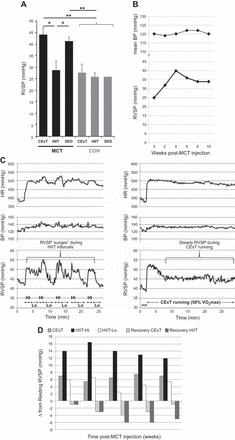Fig. 3.

Pulmonary hypertension and exercise hemodynamics. A: for rats with MCT (40 mg/kg)-induced PAH (black bars), MCT-induced elevation in resting RV systolic pressure (RVSP) was attenuated by a HIIT (n = 8) but not CExT (n = 7) approach, with RVSP of MCT-HIIT similar to that in healthy HIIT, CExT, and SED control rats (CON, gray bars, n = 5–6 ea). *P < 0.05 and **P < 0.01. B: serial measures of simultaneous RV systolic and mean systemic resting pressures (BP) in an awake freely moving rat instrumented for implantable telemetry. Recordings are shown for pre- and 2, 4, 6, 8, and 10 wk post-MCT (40 mg/kg) injection. C: real-time tracings of heart rate (HR, top) and pulmonary (RVSP, bottom) and systemic (mean BP, middle) pressures recorded via implantable telemetry are shown during HIIT running (left) and CExT running (right) for a rat at 4 wk post-MCT (40 mg/kg). Note the intermittent surges in RVSP that correspond to high (HI)- and low (Lo)-intensity intervals during HIIT that are absent during CExT. D: change in RVSP relative to resting values during a session of CExT (solid bars) and during the high-intensity (“Hi,” black bars) and low-intensity (“Lo,” white bars) intervals of a HIIT session recorded in the instrumented rat at baseline (pre-MCT) and at 2, 4, 6, and 8 wk post-MCT. Change in RVSP from resting values during recovery from both the CExT and HIIT run sessions are also indicated at each time point as hatched gray and black bars, respectively.
